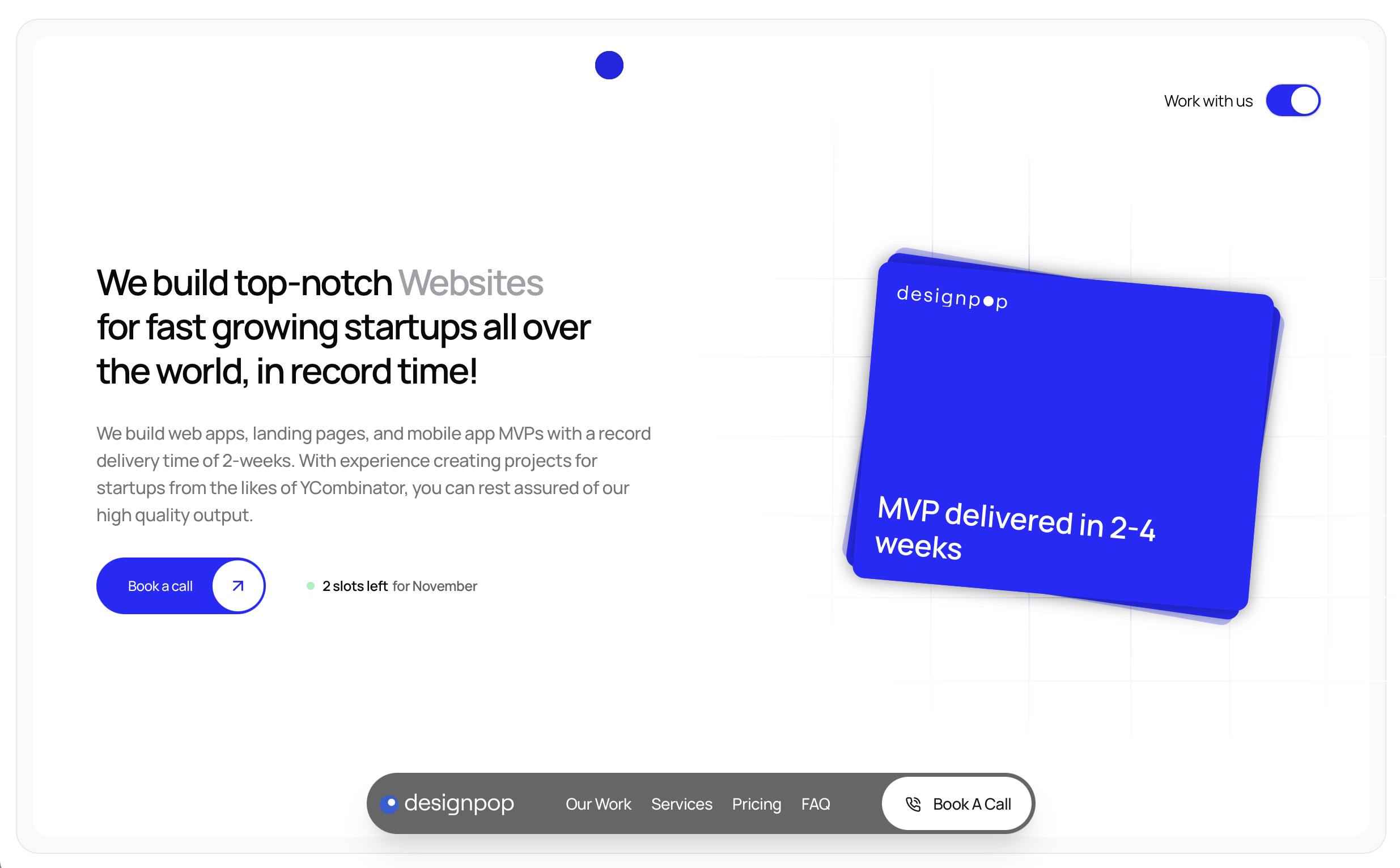$8k MRR within a year after pivoting to productized services

Moniet Sawhney learned to code at a bootcamp, worked for a handful of startups, and — once he had the chops for it — started building SaaS products. After a few attempts, he shifted his focus and tried his hand at productized services.
Less than a year later, Designpop is at $8k MRR.
Here's Moniet on how he did it. 👇
Going all in
I've always been surrounded by entrepreneurship. Many family members are industry leaders in India, and my father, after 20 years of corporate life, quit his job to start a resort and flip it for ~3x. So it's safe to say that I've always wanted to be my own boss, in one way or another.
When I started my career, I was a fresh bootcamp grad, and I knew I had a lot to prove. But after six years grinding for other startups, it felt like the right thing to go all in on my own business. I had already built and sold a small project, so I was somewhat assured I had some chops to work with.
At the end of 2023, the YC startup I was working for shut down. I took the opportunity to move to Southeast Asia and start building my business. I've always admired Southeast Asian culture, and moving there meant my runway would be a lot longer.
I'm currently working on Designpop, a design and development subscription service.
We're doing roughly $8k/mo, divided between subscriptions and one-off landing page work. We hit $1.5K our first month, then $3K in our 3rd month. It took the rest of the year to reach $8K.

Starting at a low price
We offer three packages:
MVP development with a 4-6 week timeline
Design/development subscription
Landing page design and development, including copywriting and SEO research
For pricing, we took a methodical approach and reverse-engineered what other micro-agencies did to get their initial customers. What we found was that they created buzz by creating cheap packages with high-quality work.
We knew it would be brutal, but we tried it in the hopes that it would create a network effect. We started with really low pricing — just $1k/mo for design work and $599 for landing pages. That made us $1.2k with two landing pages in the first month. And we managed to double that every two months.
Eight months in, with a few repeat customers, we grew our revenue simply by raising our prices. Once our customers were hooked on our service, providing high-quality and proactive output, it was an easy sell!
A JS-heavy stack
Our tech stack is pretty JavaScript heavy:
• Front-end: Next.js, React, React Router + Vite
• Backend: Hono.js with Node.js or Bun.js
• Database: We use Drizzle as our ORM
• Email: Mostly Resend, sometimes AWS SES
• Hosting: Cloudflare, Vercel, Hetzner, depending on project requirements
For future projects, we'll be moving to a full Bun.js stack. We find the DX to be phenomenal!
Growth via automated cold outreach
For Designpop, we did quite a bit of research to identify our target audience — and to find the online communities and keywords that could serve as channels.
Then, we created a custom bot to scrape opportunities for us. That would allow us to reach a certain quota of outreach. We figured that, as long as we got 2-3 calls per week, we could scale this to where we needed.
And it worked. This is how we got all of our users.
And I'll say this: Getting on calls gives me a great feeling of progress! It's one of the best parts of the business, compared to SaaS products.
If he did it again: Social media
With any services business, the biggest challenge is having a steady stream of customers. If I had to do it over again, I would probably focus on building an audience on socials like X, BlueSky, or LinkedIn. It takes time to crack the formula, but over a period of a year, it would have paid off.
I was initially skeptical about this approach because I wasn't sure if we'd attract an audience that would be interested in our services. But I think I was wrong. It can create a lasting network effect that can scale businesses fast.
The 3-step process of indie hacking
I think I can break down the indie hacking path into a few simple steps — mostly targeted to technical founders, as that's my perspective of indie hacking:
Build a lot of stuff. There's a lot to learn, and getting a product to be refined and competitive is hard. So I think it's important to build technical chops first. That way, you can work fast and build something that's actually good!
Be a "scene-ius": This is a mashup of the words 'scene' and 'genius'. It means that you should be observant and take every opportunity of milking new trends to gain momentum with a goal to kick off something long lasting. Advice that, I'll admit, I need to follow better as well!
Do your research: Don't build in your silo and expect people to care about your product. Find out where the customers are, how you can solve their problems, and most importantly, how you'll sell to them. The easiest way is to send a landing page that clearly shows what you have to offer. If you build interest like this and get early sign-ups, you'll launch to cheers, not crickets!
Get a cofounder
And one last thing: Get a cofounder!
It's been really great to have a cofounder on this journey. Until now, I've been working in my own silo, and it's been a refreshing experience to collaborate on building and scaling the product together.
Indie hacking is hard enough, and it's really nice to have someone to celebrate the wins with!
What's next?
We're fully focused on growing our revenue at the moment. And as I mentioned earlier, we think that social media might be a great way for us to achieve this. So, our goal for the next year would be to build an audience and grow our brand further.
You can follow me on Twitter and LinkedIn. Or learn more about Designpop at designpop.co.

Leave a Comment
Reaching $8k MRR within a year after pivoting to productized services shows smart strategy, execution, and adapting effectively to market needs.
Hitting $8k MRR within a year after pivoting to productized services shows smart strategy, execution, and the power of adapting to market needs.